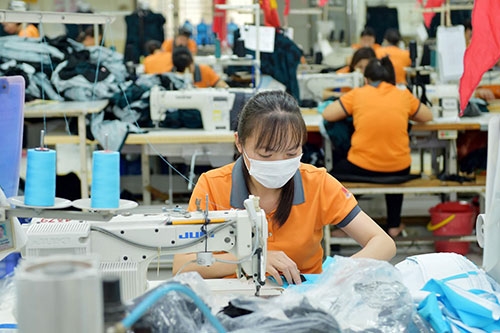Le Tien Truong, its general director, said demand for face masks and personal protective equipment will shrink rapidly.
Armed with their experience of coping with the pandemic, many textile and footwear enterprises are quietly confident of altering plans when required and finding new markets to cope with new situation after COVID-19 is under control.
    |
 |
|
Photo for illustration: thoibaotaichinhvietnam |
Sportswear has arguably been the most successful segment during the pandemic as awareness of physical exercise rose.
According to Euromonitor International, in 2020 the demand for sportswear world-wide decreased only about 8 percent, the lowest in an industry which saw an overall decline of 16 percent.
The compounded annual growth rate for the sportswear market in the last five years was 6.5 percent, 1.5 times the industry average, and it is expected to be worth 479 billion USD globally by 2025.
The Thanh Cong Textile Garment Investment Trading JSC is considered one of the most successful businesses in 2020 thanks to seizing opportunities to export COVID-19 related apparel products such as fabric masks and PPE.
But Tran Nhu Tung, its deputy general director, said the demand for cloth masks and protective gear is returning to pre-COVID levels with the advent of vaccines. This year his company has stopped taking orders for medical protective gear and antibacterial masks.
It is focusing on traditional products such as T-shirts and sportswear, demand for which would continue to increase, and there are already enough orders for sportswear for the first 6 months of the year, he said.
According to the Vietnam Textile and Apparel Association, many businesses now have orders for until the end of April, mainly for sportswear.
Dang Trieu Hoa, general director of the The Ky Yarn Joint Stock Company, said his company plans to focus on yarns with high quality and competitive prices.
The EU-Vietnam Free Trade Agreement (EVFTA) that took effect on August 1 last year has reduced tariffs on Vietnam’s garment exports by more than 70 percentage points.
The footwear and textile sectors also benefit significantly from tariff cuts, according to Bao Viet Securities Joint Stock Company.
With most other countries that export textile and garment to the EU not having a trade deal with the bloc, the EVFTA has opened up a great opportunity for Vietnam’s footwear, textile and garment exports if companies meet origin requirements, it added.
Source: VNA